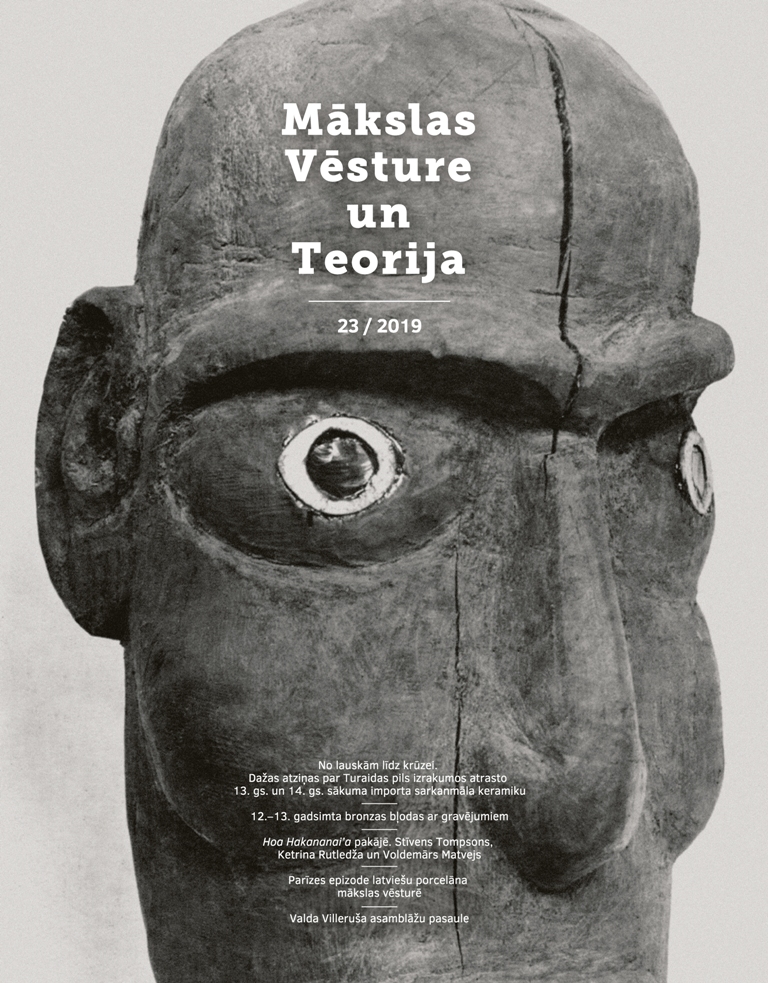No lauskām līdz krūzei. Dažas atziņas par Turaidas pils izrakumos atrasto 13. gs. un 14. gs. sākuma importa sarkanmāla keramiku
From Sherds to Jug. Some Remarks on Imported Highly Decorated Redware from the 13th and Early 14th Centuries Found in the Course of Archaeological Excavations at Turaida Castle
Author(s): Baiba Dumpe, Ieva OseSubject(s): Archaeology, Cultural history, Visual Arts, Local History / Microhistory, 13th to 14th Centuries, History of Art
Published by: Mākslas vēstures pētījumu atbalsta fonds
Keywords: Redware; Medieval pottery; Ceramics; Livonia; Archaeology; Turaida Castle;
Summary/Abstract: This article presents one outstanding group of medieval pottery imported to Livonia in the 13th and early 14th centuries – highly decorated lead- glazed redware. Several jugs graphically reconstructed from fragments found during archaeological excavations at the Turaida castle ruins are examined more closely. From the 1960s to 1990s, extensive archaeological research was carried out in Latvia in several dozens of medieval castles and ruins, as well as in Riga and some small medieval towns. Excavations on a smaller scale continue every year in the 21st century. These excavations have uncovered many thousands of fragments of pottery, made both by locals and imported from Western Europe from the 13th to the 16th century. Unfortunately, there are almost no publications on medieval pottery in Latvian. Only a few pictures without explanation of the found medieval ceramic vessels or their larger fragments have sometimes been published in archaeologists' reports on current research in Latvia. The only article devoted to a special group of medieval pottery – the redware with anthropomorphic decor from the excavations in Riga – is the publication by archaeologist Andris Caune in 1994. Other Latvian archaeologists had not yet discovered fragments of highly decorated redware in their excavation materials. Some 8000 ceramic sherds were found during the course of archaeological excavations at Turaida Castle (German – Treiden) from 1976–2000 under the direction of archaeologist Jānis Graudonis but they were not researched and dated. This collection is held by the Turaida Museum Reserve. In the last decade, the museum has begun research of the archaeological collections and already several catalogues have been published. During the research carried out for the ceramic catalogue published in 2019, about two dozen fragments of highly decorated redware covered with coloured lead glazes were found among other ceramic finds. They were sorted by the visually identifiable distinctive marks on the sherd, as well as the motifs of the décor and glaze tones. In this way, parts of more than seven jugs could be distinguished. A fragment of the rim with a spout from one jug there was found, from two other items – parts of a handle, from the next – fragments of the bases, and from most of the jugs – larger or smaller fragments of the body. The graphical reconstruction of the shape of the jugs was inspired by pictures of similar ceramics published in foreign literature. They gave an idea of the shape of such vessels and the arrangement of the ornamentation. In order to create graphical reconstructions of the Turaida jugs, the pottery fabric, colours of the glaze and surface finish characteristics were first compared. In this way fragments that matched and could be from one jug were identified. The initial location of each fragment on the body of the vessel was determined by looking at the traces from the throwing on the potter’s wheel that were left on the surface of the fragments. After measuring the curvature of each sherd, the possible diameter of the vessel was determined and the mutual location of the fragments and the profile of the jug were reconstructed. Using this method, it was possible to draw graphical reconstructions of four jugs from Turaida Castle. They represent jugs with several rows of decorative bands incised with a roller stamp as well as applied decoration – fish scales on the body. The exteriors of the jugs were partly coated with white slip and coloured lead glaze, but the interiors were unglazed or only had a few patches of glaze. Unfortunately, the sherds of the Turaida jugs cannot be dated to the archaeological stratigraphy of cultural layers, as precise documentation of the excavations is lacking. The abovementioned sherds from the highly decorated lead-glazed redware with moulded applications or anthropomorphic decoration that were found in Riga were dated from the cultural layers to the 13th and early 14th century; it was recognized that in the cultural layers from the late 13th and early 14th century there were less fragments of the highly decorated redware than in the earlier layers. According to foreign literature, similar highly decorated lead-glazed redware was made in Western Europe from the end of the 12th to the first half of the 14th century. As Turaida Castle was inhabited by Germans from 1214, the highly decorated lead-glazed redware jugs could have been imported during the 13th to the early 14th century like those detected in Riga. The exact origin of the Turaida jugs has not yet been determined. According to foreign literature, highly decorated lead-glazed redware similar to the reconstructed forms and decoration of the jugs from Turaida Castle could have been be brought to Livonia from the southern shores of the Baltic Sea – possibly from the pottery workshops located in northern Germany and southern Scandinavia. During the inventory of the archaeological ceramics collection at the Latvian National History Museum staff have succeeded in identifying several other medieval castles where highly decorated lead-glazed redware from the 13th and early 14th century has been found. A remarkable amount of such sherds was excavated not only in Riga town, but also at German castles near the Daugava River – in Ikšķile/Uexküll, Koknese/Kokenhusen and Mārtiņsala/Holme (not published yet). Turaida Castle is the fifth place in Latvia where imported highly decorated redware has been found.
Journal: Mākslas Vēsture un Teorija
- Issue Year: 2019
- Issue No: 23
- Page Range: 6-14
- Page Count: 9
- Language: Latvian
- Content File-PDF

